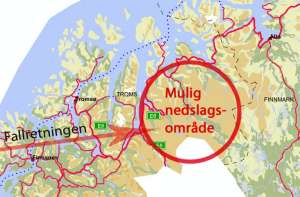Record meteorite hit Norway
 (Afenposten) As Wednesday morning dawned, northern Norway was hit with an impact comparable to the atomic bomb used on Hiroshima. At around 2:05 a.m. on Wednesday, residents of the northern part of Troms and the western areas of Finnmark could clearly see a ball of fire taking several seconds to travel across the sky.
(Afenposten) As Wednesday morning dawned, northern Norway was hit with an impact comparable to the atomic bomb used on Hiroshima. At around 2:05 a.m. on Wednesday, residents of the northern part of Troms and the western areas of Finnmark could clearly see a ball of fire taking several seconds to travel across the sky.
Mystech: A badly aimed follow up to the MPAA motivated attack on Pirate Bay?
A few minutes later an impact could be heard and geophysics and seismology research foundation NORSAR registered a powerful sound and seismic disturbances at 02:13.25 a.m. at their station in Karasjok.
Farmer Peter Bruvold was out on his farm in Lyngseidet with a camera because his mare Virika was about to foal for the first time.
“I saw a brilliant flash of light in the sky, and this became a light with a tail of smoke,” Bruvold told Aftenposten.no. He photographed the object and then continued to tend to his animals when he heard an enormous crash.
“I heard the bang seven minutes later. It sounded like when you set off a solid charge of dynamite a kilometer (0.62 miles) away,” Bruvold said.

Astronomers were excited by the news.
“There were ground tremors, a house shook and a curtain was blown into the house,” Norway’s best known astronomer Knut Jørgen Røed Ødegaard told Aftenposten.no.
Røed Ødegaard said the meteorite was visible to an area of several hundred kilometers despite the brightness of the midnight sunlit summer sky. The meteorite hit a mountainside in Reisadalen in North Troms.
“This is simply exceptional. I cannot imagine that we have had such a powerful meteorite impact in Norway in modern times. If the meteorite was as large as it seems to have been, we can compare it to the Hiroshima bomb. Of course the meteorite is not radioactive, but in explosive force we may be able to compare it to the (atomic) bomb,” Røed Ødegaard said.
The astronomer believes the meteorite was a giant rock and probably the largest known to have struck Norway.
“The record was the Alta meteorite that landed in 1904. That one was 90 kilos (198 lbs) but we think the meteorite that landed Wednesday was considerably larger,” Røed Ødegaard said, and urged members of the public who saw the object or may have found remnants to contact the Institute of Astrophysics.






